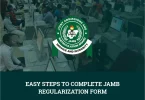JAMB Syllabus for Arabic – The Joint Admissions and Matriculation Board (JAMB) has officially released the detailed syllabus for the Arabic language examination. This syllabus is an important tool that candidates can use to guide their study and revision for the upcoming UTME exam.
To help you prepare effectively, we have provided the complete and detailed syllabus here for your reference. Additionally, you will find a list of recommended textbooks and materials to support your revision. Make sure to use the JAMB syllabus for Arabic as your study guide to improve your chances of success in the JAMB Arabic examination.
JAMB Syllabus For Arabic
| SECTION | TOPICS/CONTENTS/NOTES | OBJECTIVES |
|---|---|---|
| A: COMPREHENSION | – Passage of 70 words – 5 multiple-choice questions on passage – Topics: current affairs, sports, education, politics, economy, health, culture, ethics | Candidates should be able to: i. Use appropriate words/phrases for specific thought ii. Deduce the lesson from passage iii. Determine main theme iv. Give appropriate title v. Interpret meanings of particular words |
| B: TRANSLATION | – 10 questions: 5 English→Arabic, 5 Arabic→English – Based on standard Arabic and English usage – Includes keywords and phrases in sentences | Candidates should be able to: i. Use appropriate Arabic word/phrase for English meaning ii. Determine appropriate English word/phrase for Arabic statements iii. Interpret idiomatic expressions iv. Transfer ideas between Arabic and English v. Communicate effectively in both languages |
| C: GRAMMAR | Major Arabic grammatical features: 1. Demonstrative and relative pronouns 2. Gender (Masculine and Feminine) 3. Characteristics of noun 4. Dual 5. Plurals: a. Sound masculine plural b. Sound feminine plural c. Broken plural 6. Construct phrases 7. Separable and inseparable pronouns 8. Appendants: a. Adjective b. Conjunction c. Permutative d. Emphasis 9. Prepositions 10. Transitive & Intransitive verbs 11. The perfect verb 12. The imperfect verb: a. Indicative b. Subjunctive c. Jussive 13. The imperative verb 14. Modifiers: a. Kana and its associates b. Inna and its associates c. Zanna and its associates 15. Trilateral and derived verbs 16. Derivatives: a. Comparative/superlative b. Nouns of instrument c. Nouns of time and place d. Relative adjectives 17. Conditional sentences 18. Numerals (1 – 3000) 19. Active and passive voice 20. Nouns in the accusative: a. Direct object b. Adverbs of place/time c. Adverb of circumstance d. The exempted with illa e. Specification f. Vocative | Candidates should be able to: i. Identify demonstrative and relative pronouns ii. Compare gender markers iii. Identify three basic noun characteristics iv. Differentiate singular and dual nouns v. Construct plurals vi. Identify construct phrases and usage vii. Differentiate separable/inseparable pronouns viii. Use adjectives, conjunctions, permutative correctly ix. Apply correct prepositions x. Differentiate transitive/intransitive verbs and use them xi. Identify perfect verbs/forms xii. Identify imperfect verbs and their grammatical states xiii. Identify imperative verbs/forms xiv. Identify kinds of modifiers and apply them xv. Differentiate trilateral and derived verbs xvi. Identify types of derivatives xvii. Apply rules for conditional sentences and construct them xviii. Recognize and count Arabic numerals (1–3000) xix. Distinguish and use active/passive voice xx. Identify and use different adverbial clauses, exempted, specification, and vocative |
| D: COMPOSITION | – 5 questions on topics related to candidates’ lives and environment (education, culture, health, politics, economy, sports, current affairs) | Candidates should be able to: i. Use appropriate words for specific thoughts ii. Use correct idiomatic expressions in Arabic iii. Communicate effectively in Arabic iv. Express ideas clearly in Arabic v. Demonstrate use of common Arabic idioms and proverbs |
| E: ARABIC LITERATURE | 10 questions on literary figures and works across periods: a) Pre-Islamic Period (500–610 C.E.) – Poetic traditions and conventions b) Islamic Period (610–1798 C.E.) – Style of figurative expressions in Islamic literature c) Modern Period (1798 to date) – Modern poetic and prose works d) Arabic Literature in West Africa – Use of Arabic as medium in West African novels and drama | Candidates should be able to: i. Identify pre-Islamic poetic traditions ii. Analyze figurative styles in Islamic literature iii. Describe aesthetic features and assess modern cultural values iv. Evaluate Arabic as a medium in West African literature and analyze contents and characteristics |
Recommended Texts For Arabic JAMB 2025
1. COMPREHENSION, COMPOSITION AND TRANSLATION
.1 :يضرملا راتخم يضرملا و نیدلا ییح دمحأ ریشب .ةحضاولا ةعلاطملا .ھئانبأ و ىملا نط ةكرش :ونك
.2 .س .ل .ب ةعماجلا ةعبطم ندابإ )ةیوناثلا سرادملل( طسوتملا ىبرعلا ءاشنلإا :كلام ةرمح دیس 2005 .م
.3 :كب رمع یلع و ىربص حاتفلا دبع .ةدیشرلا ةءارقلا ءزجلا 1 – 4 .فراعملا راد :ةرھاقلا
.4 :بیطلا الله دبع ذیملاتلا ریمس ءزجلا 1 – 2 .رشنلا بتكم :موطرخلا
.5 ( ایراز .ط برغ 1999 :)م :ءاشنلإا بتكت فیك .وریاب ةعماج ةعبطم ونك
.6 :نورخلآا و ركبوبأ لولأا دمحم ةدیدجلا ةرسیملا ةیبرعلا .رشنلا و ةعابطلل مرتكبس راد :ندابإ .ةیوناثلا ةلحرملل
.7 حلا و میكح میلس و فیرش عیدب دمحم ا :ومدآ نیسح ج .ایریجین ىف ةدیدجلا ةیبرعلا باتكلا 1 – 3 اجیكإ : .نامغنول
- Adekilekun, A. L. A.: Learning Arabic Language, Ilorin.
- Balogun, I. A. B. and Oseni Z. I. (1982) A Modern Arabic Course Book 1 Lagos: Islamic Publications Bureau.
- Haywood, J. A. and Nahmad, H. M. (1965), A New Arabic Grammar of the Written Language, London: Lund Humphries.
- Malik, S. H. A. (1982) A Guide to Arabic Composition, Books I & II, Lagos I.P.B.
- Arabic newspapers, magazines and journals.
- GRAMMAR
.1 :نیمأ ىفطصم و مراجلا ىلع .ةیلولأا ةلحرملا سرادمل حضاولا وحنلا ءرجلا 1 – 3 .فراعملا راد :ةرھاقلا .
.2 :ىجاھنصلا مورجأ دمحم .ةرھاقلا .ةیمورجلأا نتم
.3 :دیمحلا دبع نیدلا ییح دمحم قملا حرشب ةینسلا ةفحتلا د .ةیمورجلأا ةم .ركفلا راد :توریب - Haywood, J.A and Nahmad, H.M (1965), A New Arabic Grammar of the Written Language, London: Lund Humphries.
- ARABIC LITERATURE
- : المأد4ة الأدب8ة للطلاب الع%<8ة ? – -1 زك%&ا حس+, : دار H إف%&ق8ا أوتG@
رونلا 2004م WAEC/NECO
2006 م WAEC/NECO H : قصص خط الاستواء: دار النور أوتG – -2 زك%&ا حس+, - لطY – -3 مصطY
NECO/WAEC ] ات ب,\وت والقاهرة (2004) : الع\ @ المنفلو] @
أحسن مكت ةمqحلا ةf@ @ m l -4 h دfع ل8مج الiنوي: ادفع 4الG
الإسلام8ة كنو (2013) WAEC/NECO
Arabic
22 - -5 أحمد الاسكندري والآخرون: المفصل ?
WAEC/NECO @] تار&ـ ـخ الأدب العرx@
TRANSLITERATION OF THE ABOVE BOOKS
1- ZAKARIYAU I. OSENI: AL-MA’DUBAT AL-ADABIYYAH.
2- ZAKARIYAU I. OSENI: QISASU KHATTUL-ISTIWA’I, DARUL NUR AUCHI.
3- MUSTAPHA LUTFI AL-MANFALUTI: AL-ABARAT.
4- JAMIL ABDULLAHI ALKANAWI: IDFA’A BIL LATI HIYA AHSAN.
5- AHMAD AL-ASKANDARI WAL AKHARUN: ALMUFASSAL FI TARIKH AL-ADABUL ARABI.
Please follow the detailed JAMB syllabus carefully as you prepare for your Arabic exam. Make sure you also study using the recommended textbooks and past questions to get the best results. If you have any questions, feel free to ask in the comments; we are here to provide timely and accurate answers.
You can also visit our page to find the syllabi for other JAMB subjects.







Leave a Comment